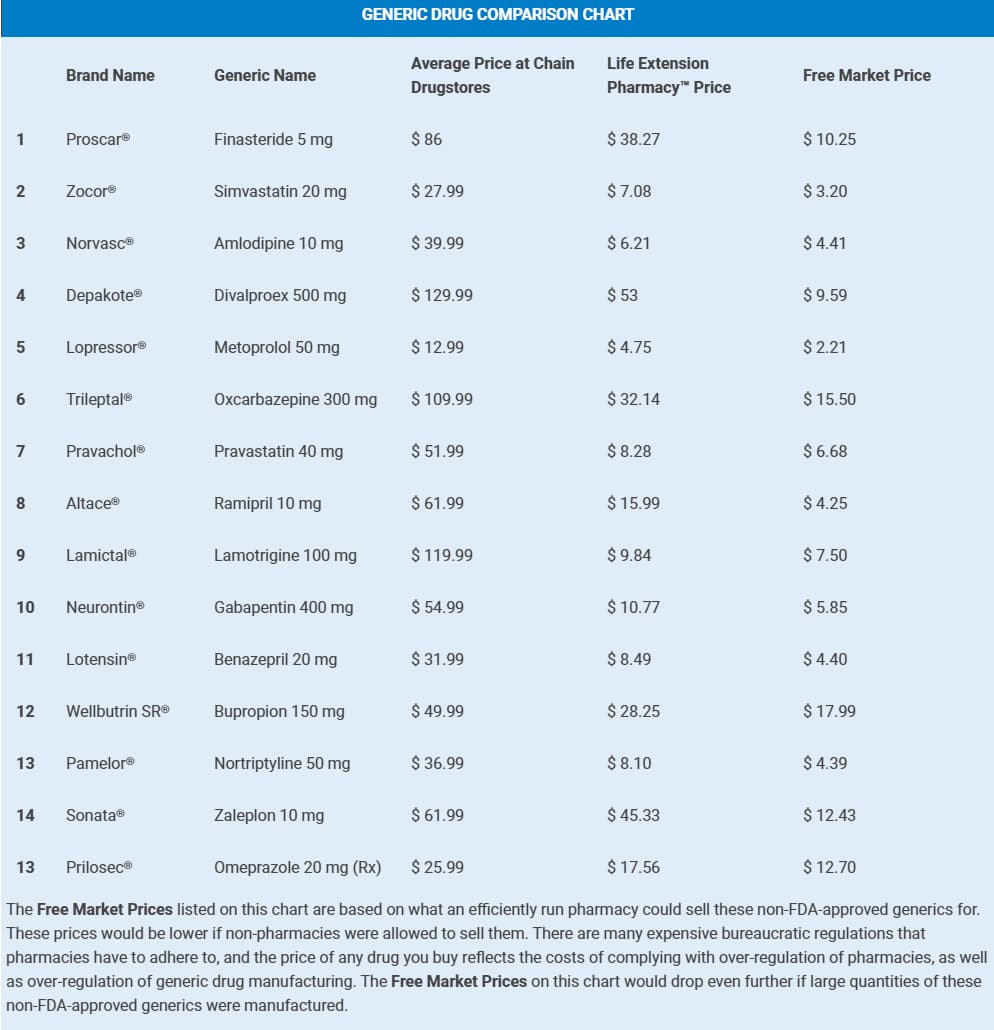Life Extension Magazine®
|
I did everything I could—including risking life in prison. Back in the 1980s-1990s, the Life Extension Foundation® crusaded to enlighten Americans about the economic ruination that would occur if this country’s corrupt drug regulatory structure was not abolished. At the behest of pharmaceutical interests, the FDA brutally retaliated against us.
What I am about to divulge is a shocking revelation about why prescription drugs cost so much. Before I describe this pervasive fraud, I want to remind readers what happens when an apathetic public allows archaic government regulations to rule the marketplace.
The Economic Collapse of Argentina
In the 1940s, Argentina was the ninth wealthiest country in the world. At one point it was richer than France and boasted a higher standard of living than Canada. It was considered one of the best countries in which to live.1
After an endless series of reckless governmental actions including uncontrolled borrowing and economic mismanagement, Argentina’s standard of living ranking has plummeted to 46th.2 If you had money in an Argentinean bank in 1999, it vanished. If you owned Argentinean government bonds, you lost most of your principal as the central government defaulted on its obligations.
Other countries have faced worse problems, including the mass murder of their citizens in one form or another by the central government.
The reason I mention Argentina is that its economic collapse has similarities to what the United States is facing.
Misguided and corrupt government policies, combined with citizen apathy allowed financial ruination to happen in Argentina. We in the United States are not immune to the same calamity.
If what I expose in this article does not motivate citizens to take action, I don’t know what will. It is beyond my comprehension that the common-sense free market solution I propose will be ignored by the American citizenry.
Health Care Costs Bankrupting United States
 |
Everything Life Extension® predicted about the health care cost crisis is happening before our eyes. Major corporations, individuals, and the government are being bankrupted by out-of-control medical costs. Some say the economic challenges facing the United States will result in substantially reduced standards of living. This does not have to happen.
As we long ago identified, the cause behind spiraling medical costs is a crooked and ludicrous regulatory structure.
Today’s health care cost crisis is widely acknowledged and feared. No one, however, has yet proposed a practical solution to resolve it.
Even We Are Selling Overpriced Drugs
Three years ago, we established the Life Extension Pharmacy™ to provide members with unique health services and the lowest drug prices. Even though our prices are consistently at the rock bottom end of the marketplace, you still grossly overpay for generic drugs—no matter where you buy them.
The reason for high-priced generics is not because the active ingredients are expensive. On the contrary, compared with complicated nutrient extracts, the ingredients in drugs are usually synthetic chemicals that cost only pennies a day.
The culprit behind overpriced generic drugs is an archaic regulatory environment that functions to protect pharmaceutical financial interests, forcing consumers to pay artificially inflated prices for their generic medications.
If our proposal to overhaul today’s inefficient regulatory system succeeds, at least part of the health care cost crisis will disappear quickly. A side benefit to lower-priced generic drugs is that it will force pharmaceutical companies to bring out life-saving medications faster, since almost-as-good generics will cost virtually nothing.
An Example of a Grossly Inflated Generic Price
Once a brand drug comes off patent, generic equivalents emerge, but they cost far more than they need to because of FDA over-regulation.
Take the drug finasteride (Proscar®) for example. It came off patent in 2006, but at the end of 2008, chain pharmacies were charging about $90 for 30 tablets (a one-month supply). All it takes to make this drug is to put 5 mg of finasteride into a tablet that dissolves in the stomach. Vitamin companies do this every day with nutrients, but the FDA does not allow them to freely do the same thing with drugs.
 |
We checked on the cost of buying finasteride and making it into tablets. The free market price for 30 tablets is only $10.25, which includes an independent assay of the ingredient quality, potency, and tablet dissolution—and a reasonable profit margin. It is against the law, however, for GMP (Good Manufacturing Practices)-certified vitamin manufacturers to offer low-cost generic drugs. This prohibition must be lifted as America can no longer afford to subsidize those who are politically connected while the country is driven into insolvency.
Finasteride is a drug that not only helps relieve benign prostate enlargement, but may also reduce the risk of prostate cancer.3-5 Widespread use could save Medicare lots of money in expensive prostate treatments. Those who follow Life Extension®’s other recommendations would be expected to reduce prostate cancer risk even more.
As evidence mounts about the prostate cancer risk reduction associated with drugs like finasteride, more companies are competing to make it, but its average price at chain pharmacies is around $86 a month—a staggering eight times higher than what its free market price would be!
Please note that generic prices tend to wildly fluctuate. In this case, as more competitors entered the market, chain pharmacies did not substantially lower the price of finasteride. In some cases, the opposite occurs, and by the time you read this, the price could vary.
How the “Generic” Regulatory System Works
If a company wants to manufacture a generic drug, be it a prescription drug like finasteride or an over-the-counter (OTC) drug like ibuprofen, it must file an Abbreviated New Drug Application (ANDA) with the FDA, even if it is manufactured by others already.
While the company does not have to perform clinical trials for an ANDA, it does have to show its bioequivalence to the original drug. For drugs that are difficult to synthesize, this requirement is important. For most drugs, however, the raw material can be purchased, often from the identical supplier that provides it for the branded drug.
To show bioequivalence, the company typically needs to perform human studies that take 1.5-2 years, unless a sufficient number have already been performed successfully, in which case it might be able to use those prior studies to support the ANDA. But the FDA could reject the ANDA and require the company to perform studies anyway.
The cost and time involved in the ANDA process varies, depending on the drug, its safety, how long it has been on the market, etc.
To have an ANDA approved, it typically requires an investment of about $2 million, and it takes a total of two to three years to get the drug to market.
To manufacture a common drug like ibuprofen (the active ingredient in Advil® and numerous other OTCs) might cost about $1 million and take 1.5 years, because the company would not have to do its own studies, and because it is a drug with a known safety profile.
In addition to these costs, a company should budget 15% for legal fees, because wherever there is a big manufacturer with a sizable market share involved, they will sue, just to try to eliminate more competition from the market.
One’s political connections with the FDA are critically important. Those who are not in the FDA’s good graces might find it more difficult to get an ANDA approved. The company should have experience with this bureaucratic process to know when and how to object to unreasonable FDA requirements.
So as you can see, what should be a straightforward process to manufacture drugs like finasteride instead turns into a bureaucratic quagmire that results in generic drugs costing far more than they need to. If a person was to take 5 mg finasteride tablets made by a vitamin manufacturer, all they would need to do to document its efficacy would be to test their blood levels of dihydrotestosterone (DHT). Finasteride alleviates benign prostate enlargement symptoms by inhibiting the 5-alpha-reductase enzyme that converts testosterone into DHT. Properly made finasteride will lower DHT.
Under a free market system, consumers would have the choice of paying $86 for a one-month supply of FDA-approved generic finasteride, or $10.25 for a one-month supply of generic finasteride made by a GMP (Good Manufacturing Practices)-certified vitamin manufacturer.
 |
How Much Are You Overpaying?
Life Extension® investigators have spent an enormous amount of time identifying what it really costs to make a generic drug. The price of the active ingredient for most drugs is remarkably low. A greater expense involves GMP manufacturing and the kinds of quality control measures that we at Life Extension® mandate for the supplements that carry our label.
The chart on this page reveals the shocking numbers. Compared with what chain pharmacies are charging today, the free market prices are an astounding 51% to 94% lower!
On average, Americans are paying 837% more at chain pharmacies and 236% more at the Life Extension Pharmacy™ compared with what the free market price would be for the identical medications.
When looking at the ultra-low free market prices, it becomes evidently clear that there is no real prescription drug cost crisis. A month’s supply of some of the most commonly used drugs could be obtained for the price of a box of cereal.
There never was a need for Congress to pass the thoroughly corrupt Medicare Prescription Drug Act that involves the massive expenditure of tax dollars to pay full retail prices for these hyper-inflated drugs.
The free market price of generics would be so low, in fact, that even those with medical insurance will save money on most drugs compared with what their co-pays are now.
If these free market medications became available, medical insurance premiums will be lowered, Medicare’s day of insolvency postponed, and many businesses and consumers spared from bankruptcy. The chart above reveals how little free market generic drugs would cost.
The inevitable concern raised by this free market solution is safety. Who will protect consumers from poorly made generic drugs?
First of all, there will be the same regulation of these drugs as there are with GMP-certified supplement makers. FDA inspectors will visit facilities, take sample products, and assay to ensure potency of active ingredient, dissolution, etc. Laboratories that fail to make products that meet label claims would face civil and criminal penalties from the government.
 |
Secondly, there is no incentive not to provide the full potency of active ingredient in these less-regulated generic drugs. The price of the active ingredients makes up such a small percentage of the overall cost that a manufacturer would be idiotic to scrimp on potency.
Companies that foolishly make inferior generics will be viciously exposed by the media, along with the FDA, consumer protection groups, and even prescribing physicians who will be suspicious if a drug was not working as it is supposed to.
Companies producing inferior products will be quickly driven from the marketplace as consumers who choose to purchase these lower-cost generics will seek out laboratories that have reputations for making flawless products.
These substandard companies would not only be castigated in the public’s eye, but face civil litigation from customers who bought the defective generics. When one considers that GMP-certified manufacturing plants can cost hundreds of millions to set up, a company would be committing suicide if it failed to consistently produce generic drugs that at least met minimum standards.
Mollifying the Cynics
No matter how many facts I list showing that these free market drugs will be safe, there are alarmists who believe that even if one person suffers a serious adverse event because of a defective generic drug, then the law should not be amended to allow the sale of these less-regulated products.
What few understand is that enabling lower-cost drugs to be sold might reduce the number of poorly made drugs. The reason is that prescription drug counterfeiting is a major issue today. Drugs are counterfeited because they are so expensive. With a month’s supply of free market simvastatin selling for only $3.20, it is difficult to imagine anyone profiting by counterfeiting it. So amending the law to enable these super-low-cost drugs to be sold might reduce the counterfeiting that exists right now.
Another reason these less-regulated generics will do far more good than harm is that people who need them to live will be able to afford them. The media has reported on heart-wrenching stories of destitute people who cannot afford even generic prescription drugs. They either do without, or take a less-than-optimal dose. The availability of these free market generics will enable virtually anyone to be able to afford their medications.
Preserving Our Country’s Financial Future
The cost of prescription drugs is a significant factor in today’s health care cost crisis, a problem that threatens to bankrupt consumers and this nation’s medical system. Passage of common-sense legislation would quickly slash the cost of generic drugs so low that consumers could obtain them for less than what their co-pays currently are. Enormous amounts of money would be saved by public and private insurance programs, and ultimately consumers.
According to the Government Accountability Office (GAO), all federal revenue will be eaten up by government outlays for Medicare, Medicaid, Social Security, and public debt interest by 20258,9—just 16 years from now!
We as a nation can no longer afford to be bound by today’s inefficient regulatory system that artificially inflates the cost of our prescription medications. The money is no longer there to support this bureaucratic morass.
Fight Back Against This Institutional Corruption
The United States of America faces a health care cost crisis that will render Medicare and many private insurance plans insolvent. Next month I will reveal shocking details about how bad Medicare’s finances really are.
When terrorists attacked the United States in 2001, there were patriotic Americans who enlisted in the armed services. Many lost their limbs, their vision, and their lives.
No one has to engage in physical combat to save this country from the institutionalized inefficiencies and corruption that plague today’s disease-care system. All you have to do is type-in www.lifeextension.com/lac on to your computer and easily send a copy of this article to your Representative and two Senators (along with the letter that appears at the end of this article "Letter to Washington").
Just punch in your name and address, and our Legislative Action Center locates your Representative and Senators. It is that simple to take affirmative action to help save our country from the insolvency so many countries chronically suffer with.
This article will be read by over 300,000 Americans. In previous legislative initiatives, fewer than 6,000 people bothered to spend a few minutes logging on to our convenient Legislative Action Website. This kind of citizen apathy is why the federal government continues to trample our liberties and empty our pocketbooks.
The form letter below "Letter to Washington" can be printed (along with this entire article), and mailed to your members of Congress. To find out where to mail these letters, call 202-224-3121. It is of course much more convenient to log on to www.lifeextension.com/lac
I sincerely hope that after reading this article, not one Life Extension® member will fail to take this simple action to help protect this nation’s economic future.
For longer life,

William Faloon
1. www.wikipedia.org/wiki/Argentina.
2. www.hdrstats.undp.org/en/2008/countries/ country_fact_sheets/cty_fs_ARG.html.
3. Rev Urol. 2003;5(Suppl 5):S12-21.
4. Urology. 2009 May;73(5):935-9; discussion 939.
5. Prostate. 2009 Jun 1;69(8):895-907.
6. www.lifeextension.com/magazine/ mag2001/may2001_cover_pearson2_1.html.
7. www.citizen.org/congress/reform/rx_benefits/ drug_benefit/.
8. www.money.cnn.com/2009/05/06/news/ economy/obama_budget_cuts/index.htm.
9. www.house.gov/budget_republicans/ entitlement/roadmap_detailed_entirereport.pdf.

